Jack Daniels — the top selling American whiskey in the world and second globally only after Johnny Walker — is made in Lynchburg, Tennessee. All of it.
Get this: Like many towns in the American South, Lynchburg is in a dry county”¦ meaning the sale of alcohol is illegal there. Can you believe it?
(Fair warning to those of you who aren’t enormous nerds like me”¦ this entire post is probably TMI for you. To the rest – join me in riveting factoids and fascinations!)
Yeah. So. Illegal to sell booze in Lynchburg. 1Whose namesake is up for debate, but let’s all just agree it’s a bit awkward. I mean, would you want to go to Guillotineville? Or ElectricChairVille? Thought so. So how does the distillery – descended upon by thousands of visitors per day – get away with vending their liquid gold to those who’ve made the journey from the freeway? It’s all about the money. A special legal concession for a special tax revenue, of course!
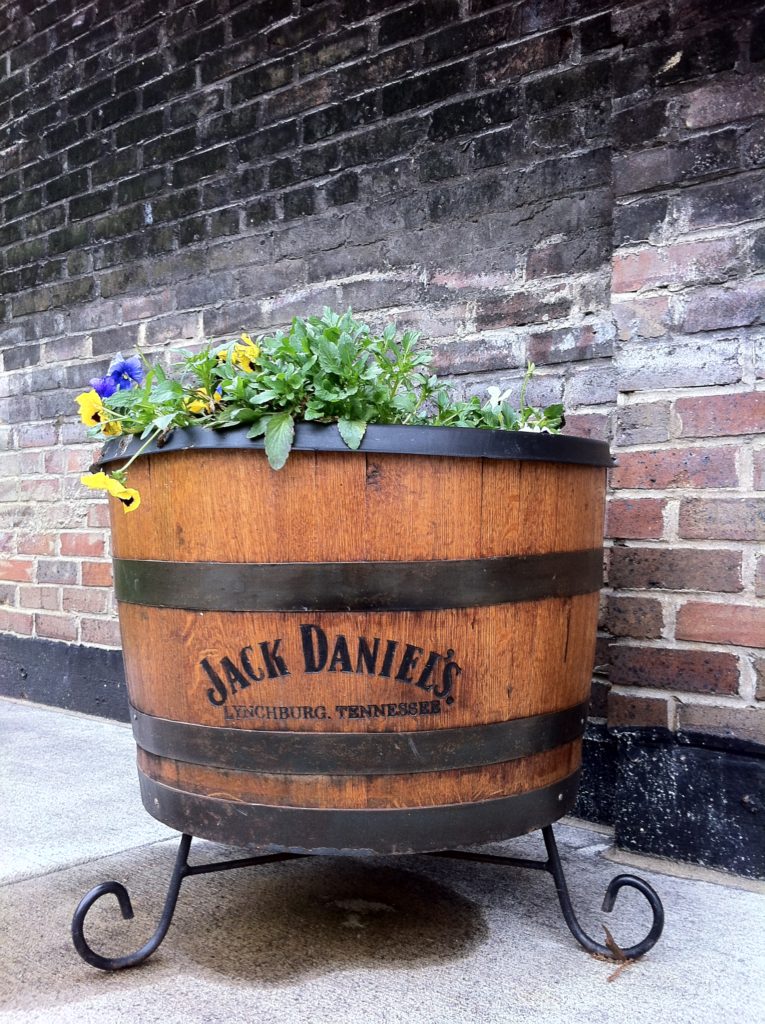
Okay, okay… if y’all are going to provide 99.9% of the county’s tax revenue… I guess you can sell booze. Sheesh. But only you.
I didn’t personally avail myself of the opportunity to buy booze in Lynchburg, Tennessee. I hopped on the top-shelf tour, though. I mean, if you have any appreciation for barrel spirits (I do!), it might as well be the good stuff. My guide, Ben was super knowledgeable and tolerated my many, many, many questions. You have him to thank for the following:
Small Man, Big Beginnings
Jasper Newton Daniel, who everyone always called Jack, started making whiskey as a kid in the 1850’s. You read that right. Maybe that’s why he never grew taller than 5’2″. (Okay, maybe that part is because people were short in the 1800s.) Jack was the runt of his family of 10 who took off for greener pastures at the tender age of 6. He moved in with a neighbor who hired him for help around the house. Said neighbor originally turned down Jack’s request to participate in neighbor’s side-business running a still. After a year of seeing this young spit-fire’s unique spirit, he relented.
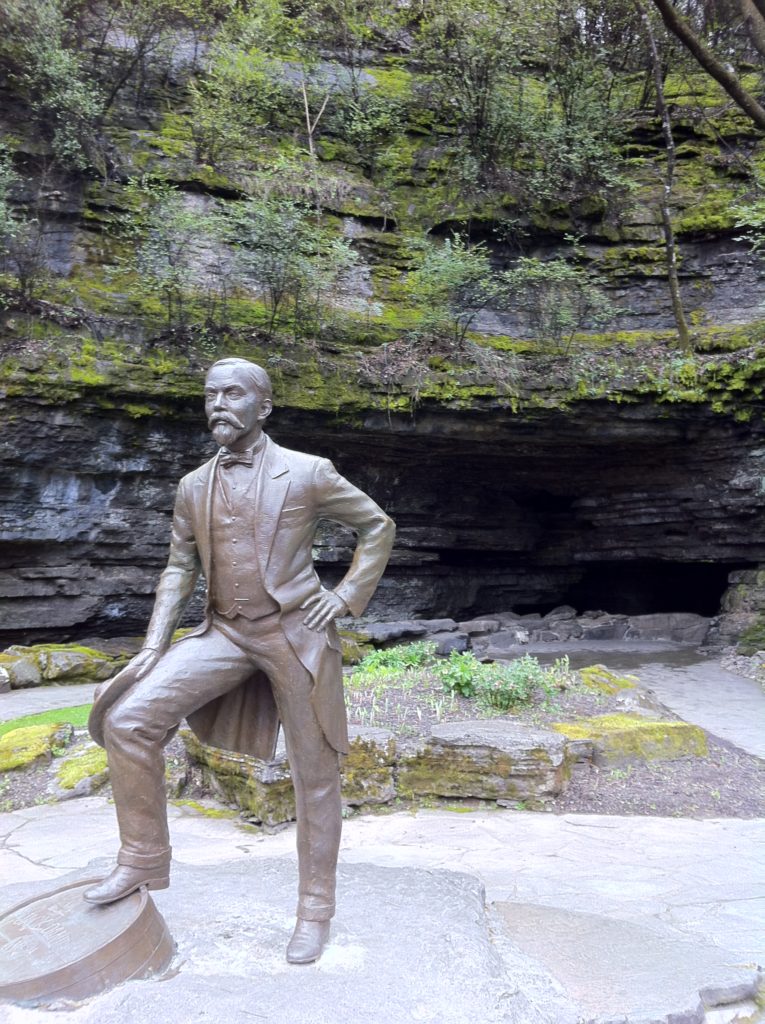
I guess artistic license includes rendering someone a good half-foot taller than they actually were? (Pictured – Jack’s likeness in front of the cave with the spring that supplies all the water for the whiskey making!)
Six years later, Jack bought all the equipment off the man who had taken him in. The neighbor, you see, was also a minister. The church finally said, “It’s us or the booze. You pick!”
Jack kept cranking out whiskey, bought the Lynchburg property in his 30’s, and two decades later was launched to global notoriety when he won the gold medal for “World’s Finest Whiskey” at the St. Louis World’s Fair – just after the turn of the century.
Good ol’ prohibition threatened to suffocate a good thing, but Jack limped along on a loophole similar to the one that has seen American marijuana growers through the 90’s and new millennium: medicinal use.
I learned that the greatest threat to bootleg moonshiners without a loophole on their side was (and still is!) fungus. Colloquially known as distiller’s mold, this black fungus loooooooooves ethanol and grows prolifically in its presence. It coated every building, tree, vehicle, and surface on the Jack Daniel’s property. Someone producing illegally will have a hard time hiding a few hundred billion fungus spores when the sheriff comes a-knockin’.
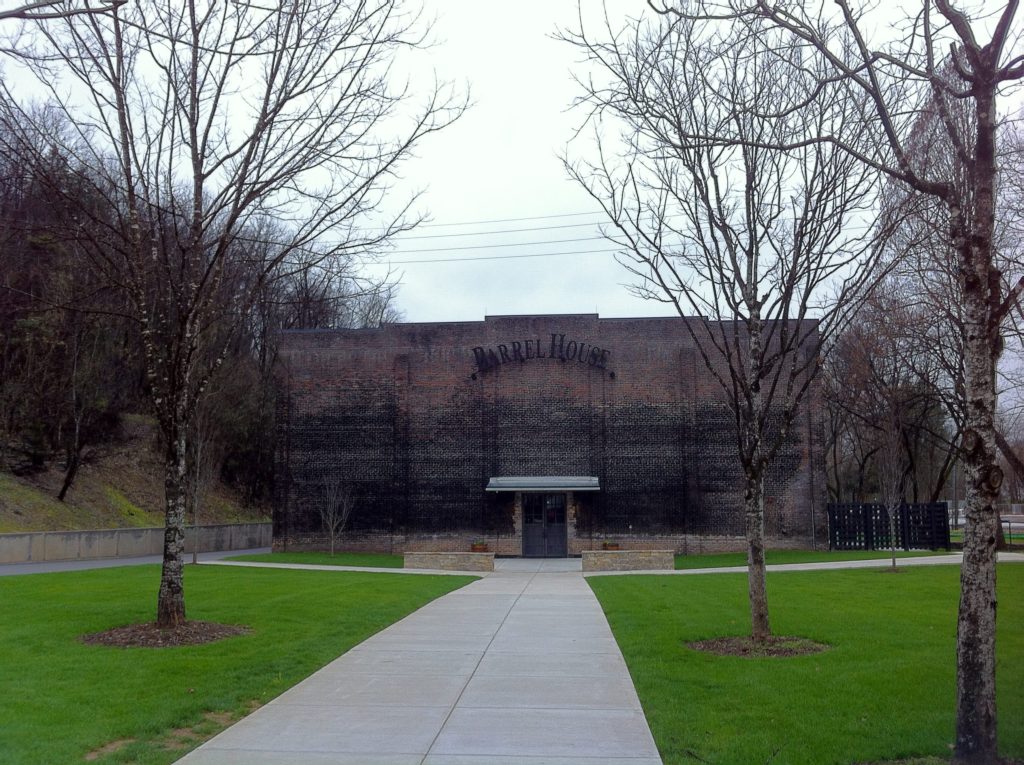
You’d maybe guess emissions from coal heat were to blame for the film of black on everything, but you’d be wrong. Tour guide pointed out those who use ethanol-impregnated gasoline might experience “distiller’s mold” around our gas caps. Check it out!
Right. So Jack survived being born into a family with too many kids, he survived an age-ist world that thinks kids shouldn’t learn to make booze, he survived prohibition, and now the label he started pulls in 80% of the revenue for the parent company that owns Jack Daniels. 2He did not survive kicking a safe that was too hard to open, breaking his toe, getting gangrene, slowly having parts of his leg amputated for six years, and eventually dying of complications. But that’s another story.
Given the dude’s obvious visionary brilliance, the head honchos shun most of the more modern and efficient processes for making whiskey in favor of Jack’s process.
Water is Queen
Because water is almost 100% of any spirit, distillers will tell you the source of that water is everything. Jack Daniel’s water comes from a cave spring in a freaking gorgeous mini-canyon of stratified limestone. Translations: southerners call these mini-canyons “hollows.” And by stratified, I mean the awesome visible layers that make it look like you’re surrounded by stacks of giant pancakes. Ferns clung to the weepy hollow walls, and mosses softened the black stone. Beautiful!
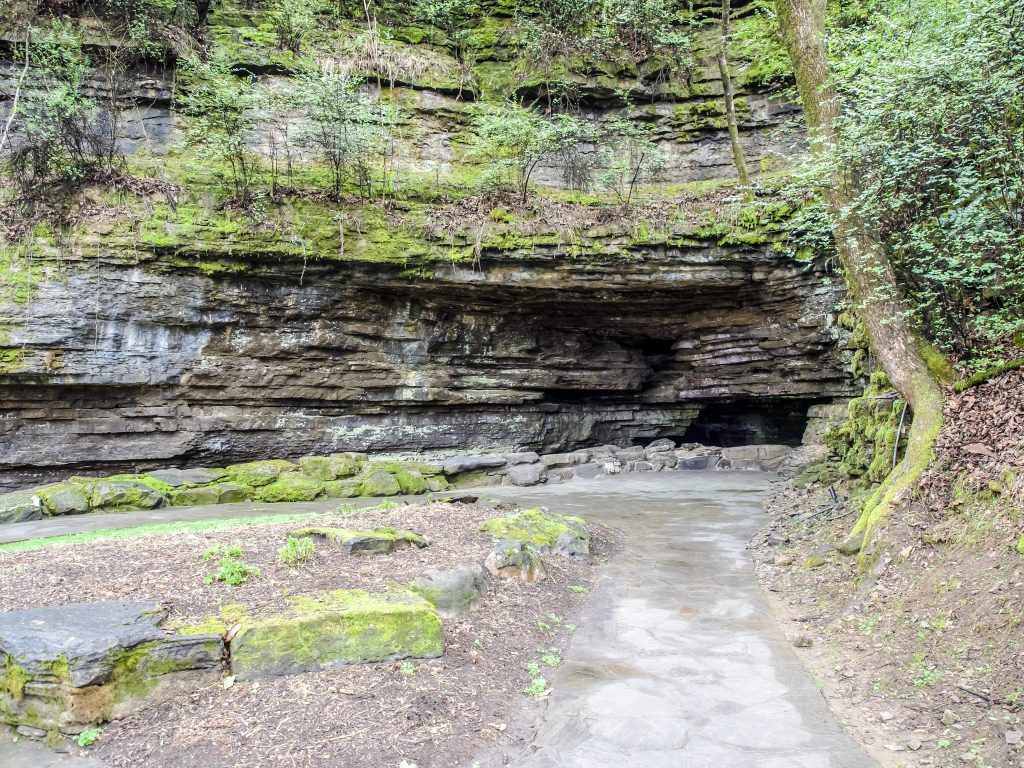
Stunning, right? Mother nature sure is a great artist. photo: ashley smith, head badass at mywanderlustylife.com
That the Jack Daniel’s water comes from a limestone cave is basically mother earth’s natural Brita filter, ensuring that things like iron (which can be problematic in the brewing process) are a non-issue. Back in the pre-refrigeration days, the consistent temp of the water was crucial to obtaining the condensation needed in the distilling process.
Grain Goodness
Jack was known to be quite a snob about his corn, barley, and rye. They use a 20:3:2 380%, 12%, 8% ratio in the recipe. Incoming grains were and are vetted for tight moisture and starch parameters. Maintaining Jack’s exacting standards these days also involves eschewing shortcuts used to dial in modern brewing recipes – namely the addition of sugar and chemical enzymes.
Before one can have spirits, one must make beer 4or wine, depending on your final product. Many call the boiled and fermented grain “distillers beer.” Just like sourdough and many other fermented product processes, a glug of leftovers from the previous distiller’s beer batch is added to the new one. We weren’t allowed to take photos of the giant vats of fermenting slurry, but it’s hard to forget the churning yellow porridge. The yeast in the brew splits sugar in the grain into gas and alcohol. The escaping gas makes the fermentation mass look like it’s at a rolling boil. In reality, temps over 85 ° F would kill the yeast.

Such a tiny grain. Such malty deliciousness.
After five or six days, the beer is ready to make the journey to the still, where 40,000 gallons of “beer” becomes 8,000 gallons of whiskey. The 32,000 gallons of leftovers become their own product chain. The 8,000 gallons of whiskey appear after the mash is slowly dropped through a silo of copper trays with holes in them like a colander. The whole process is heated to about 174 °F, the temperature at which alcohol breaks free of bondage from the slurry.
Guess how many stills are needed to supply the entire world with Jack Daniels.
Six!
Born From a Bourbon
Up to this point in the recipe, we’ve made bourbon. To get to “Tennessee Whiskey,” the local pyros have to hop onboard. How to get the corn oil and fatty acids out of the bourbon?
- Cut up a bunch of sugar maple into two-inch lengths.
- Build a few giant Jenga towers leaning on each other. And call it by its proper name: a rick.

Here you have it, ladies and gents. The rick, in all it’s unphotoshopped, amateur photographer glory.
- Douse said tower in 140 proof moonshine.
- Light it on fire.
- Stand there while it burns for 90 minutes.
- Be proud if your Jenga tower collapsed just when it was supposed to – enough to smother the burn such that it produces charcoal and not unburnt wood or ash.
- Spray water into places that are getting too hot and threatening to turn to ash instead of charcoal.
- Break the charcoal into tiny pieces.
- Pack it so tightly into giant 14 foot vats that it takes the bourbon three days to seep from the top to the bottom.
- Pull the finished product out the bottom, seeing happily that the charcoal has added no flavor or color, only removed impurities.
- Call it Tennessee Whiskey – even if it wasn’t made in Tennessee. If you charcoal mellowed it, you followed the Tennessee process and can say so.
How long do they use the charcoal? Glad you asked. They taste test every three weeks to be sure, but a vat of charcoal is usually good for five months. When they change it out, they rinse it first with water that is re-distilled to capture the booze that was lingering in the charcoal. The leftover charcoal is then turned into smoking pellets. (They’ve got a use for everything at Jack Daniels. They’re currently at a 98% recycle rate with a goal to hit zero landfill by 2020. That seems pretty alright.)
Barrel Badassery
So important are the oak barrels in which the charcoal-mellowed alcohol is aged, that the distillery makes their own. And uses a brand new barrel each time. They call the barrel “an ingredient.”
First the barrel goes through a toaster oven, which brings out vanilla flavors and such. Then it’s straight-up lit on fire, which caramelizes the sugars in the wood.
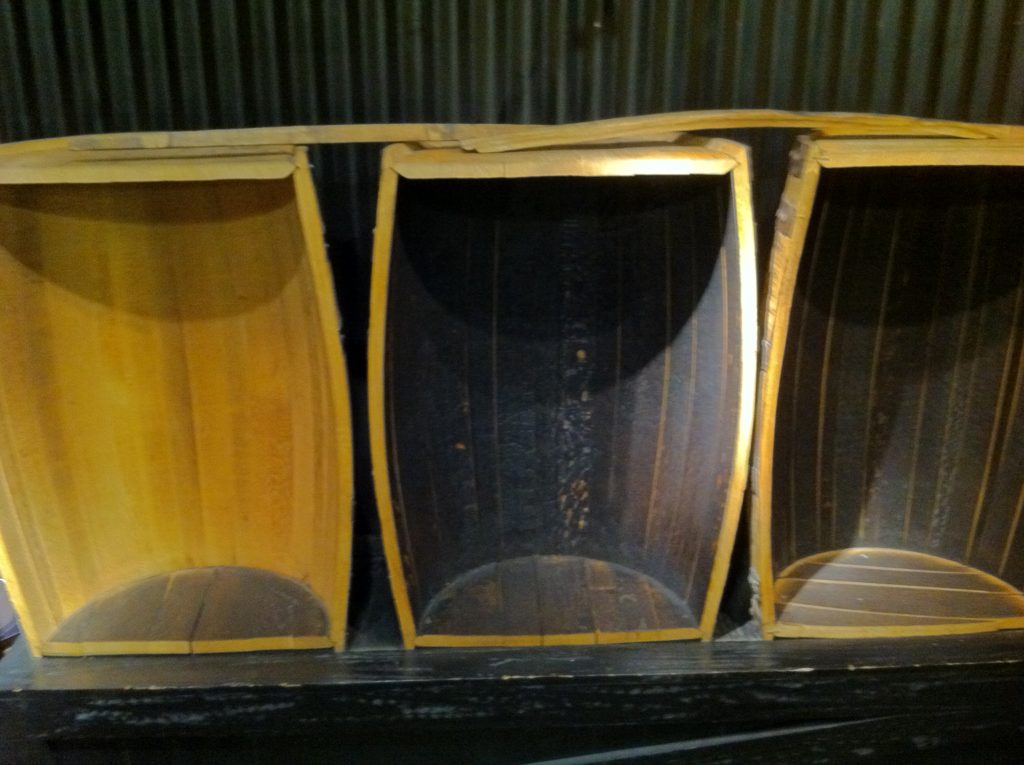
Barrel magic. Delicious.
Once filled, the barrels take up residence in one of 89 barrel houses all within a five-mile radius of that limestone cave pumping out the water used to make Jack. In the barrel house, stacks rise seven levels skyward. A plumb line hangs from the center to warn workers if thousands of pounds of wood and booze is posing a threat to the structure.
The middle floors are where the black label is born. The top shelf brands are born, unsurprisingly, at the greatest heights in the barrel house. The green label – a.k.a. the “cooking, hard times, college days” whiskey – comes to life on the bottom racks. Why?
The houses aren’t temperature controlled, It’s the variability that lends the whiskey its amazing flavors. Not sure if you’ve heard that warm air rises, but essentially the temperature fluctuations are greater at the highest reaches of the barrel houses. That means the spirits get pushed into the barrel wood and back out with more intensity than in lower barrels, gathering more flavor and color.
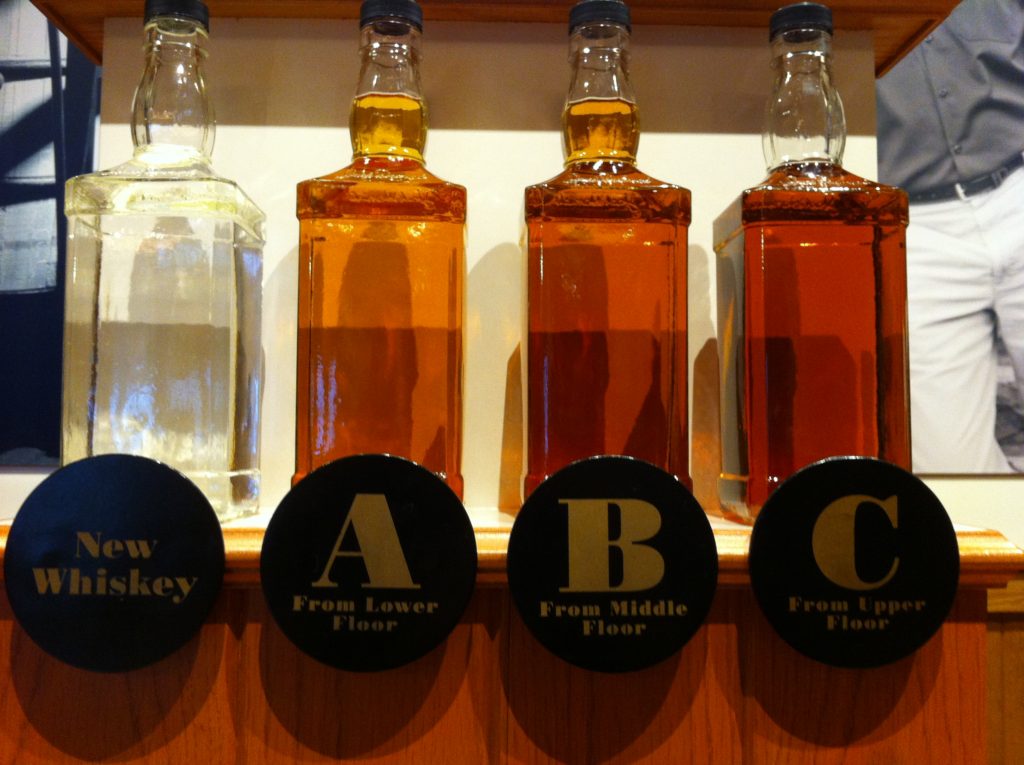
Same exact product, same exact time in barrels (save the control). Only altitude varied. Cool, right?! (Pardon the crotch shot. Inadvertent.)
And then what? Well, we’ll get to that. But I’m sure what you’re really asking is, “What happens to all those ‘only used once’ barrels?” A majority – 80% – go on to make a name for themselves in the scotch-production world. The rest are mostly used in other booze making processes – think barrel-aged porters, etc. Some niche products, like tabasco sauce – account for the rest.
Listen to the Whiskey
Because of the unpredictability of the Tennessee weather and temperature, you’ll never see a label-claim on a bottle of Jack regarding the number of years it was aged. 5The opposite – predictable temperature in whiskey and scotch-famous Ireland and Scotland – is why their labels do proudly announce a timed process. Over the four to seven years the whiskey spends inside the barrel, the temperature ranges from 20 ° to 95 ° F. As above, the fluctuations force the whiskey into the oak or cause it to withdraw. Expert tasters decide when the distinct Jack Daniel’s flavor has been achieved. Tough job, but someone has to do it.
Sadly for the business’ bottom line, all that expansion and contraction means an inevitable 5-10% loss. They’ve tried to make tighter barrels to counteract the phenomenon, but all they managed to do was make explosions.
Once the spirit is in the bottle, you’ve got about 50 years before you’ll start to see evaporation loss. Who would have a bottle of Jack around for 50 years? Well for starters, how about someone who bought 250 bottles at once via the Buy-the-Barrel program?
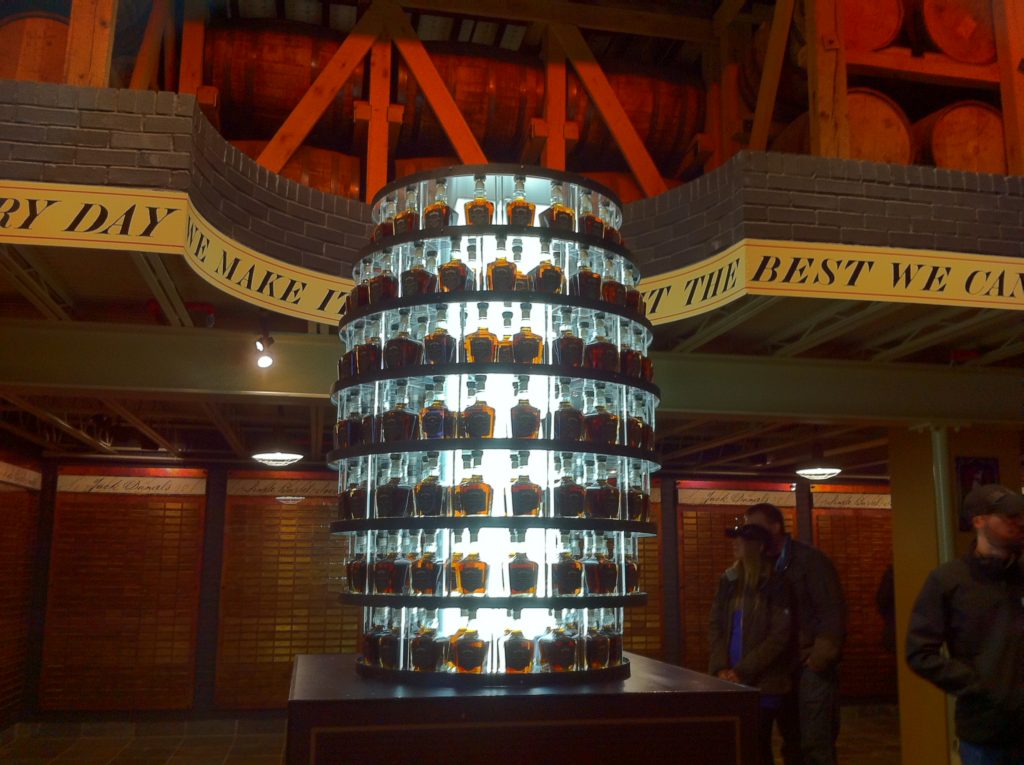
Here you have it – a barrel rendered into its final form: 250 bottles
Why would someone do such a thing? Two reasons. First – you get a hella discount if you buy 250 bottles (i.e. a barrel) in one shot. Depending on your state’s booze tax rate, you’ll pay between $9,000 and $14,000 – a several thousand dollar savings. Second – If you’re a real connoisseur, then you’ll notice subtle differences that, despite the same recipe always being used, are a defacto part of the booze making process. When you buy the barrel, you get to sit down with the head honcho, taste three different top-shelf barrels, pick the one you like best, and never have your whiskey deviate from perfection ever again. Or at least as long as it takes you get through 4,000 rounds of sipping. Even a heavy drinker would be set for at least a few years.
If you’re a celebrity like Frank Sinatra, you can skip the buy-a-barrel program and just head straight to having the company make a whiskey specifically for you. In fact, one major facet of the company’s success (aside from winning world’s best at that 1904 fair) is probably that time Sinatra took his glass out on stage with him and declared, “Ladies and gentlemen, this is Jack Daniel’s, and it’s the nectar of the gods.”

Frank’s barrels were grooved to unlock a whole new level of flavor in that whiskey aficionado’s palette. Uh… and the barrels were blurry in real life, too. 😉
Maybe the 300% growth the company experienced the following year had nothing to do with Sinatra’s tribute. His love was real, though. The man is buried with a bottle of black label Jack!
You know who else loves Jack Daniel’s? Americans. And Brits. And Australians. The latter two are the biggest importers of Jack in the world. If California ever achieves the dream of becoming its own country, it would take third in that ranking list.
I’ll leave you with that. Now I’m thirsty. Cheers, y’all. And…
Happy Travels! ♣
References
| ↑1 | Whose namesake is up for debate, but let’s all just agree it’s a bit awkward. I mean, would you want to go to Guillotineville? Or ElectricChairVille? Thought so. |
|---|---|
| ↑2 | He did not survive kicking a safe that was too hard to open, breaking his toe, getting gangrene, slowly having parts of his leg amputated for six years, and eventually dying of complications. But that’s another story. |
| ↑3 | 80%, 12%, 8% |
| ↑4 | or wine, depending on your final product |
| ↑5 | The opposite – predictable temperature in whiskey and scotch-famous Ireland and Scotland – is why their labels do proudly announce a timed process. |




Twitter Facebook Google+ StumbleUpon Reddit Pinterest